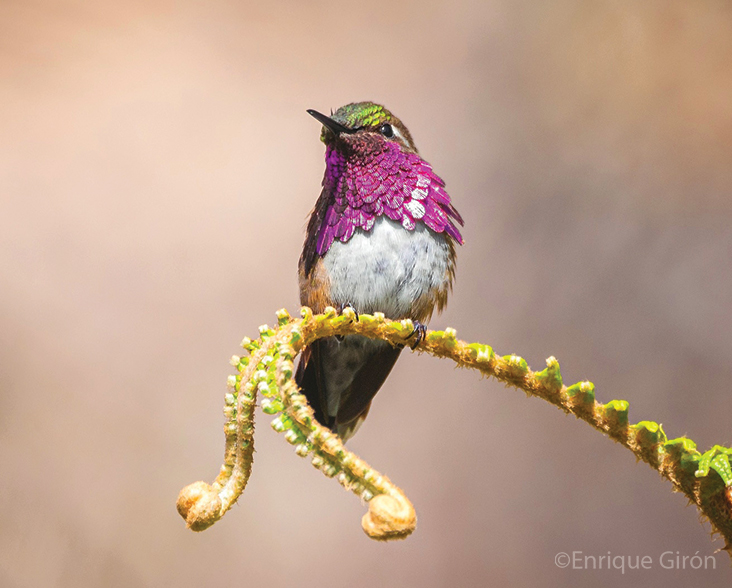Wine-throated Hummingbird
Species Data
Class: Aves
Order: Caprimulgiformes
Family: Trochilidae
Scientific Name: Selasphorus ellioti
IUCN Red List status: Least Concern
Description
This tiny hummingbird measures at just 6.5-7cm long and weighs a mere 2.3-3.5 grams. Males have green upperparts and an expansive, glittering magenta-pink gorget with violet highlights. The flanks are a mix of cinnamon and green and the rest of the underparts are white. They have a rather short tail with a rusty-coloured base and white corners on the tail tips.
Females also have green upperparts, but in comparison to males they have a white chin and throat with many dark, dusky spots. Their tails have more black than males, and the outer feathers tips are more cinnamon than white.
Both sexes have a short, straight, blackish bill and a small white spot behind the eye.
The Wine-throated Hummingbird was formerly placed in the genus Atthis, together with the Bumblebee Hummingbird (Selasphorus heloisa). Both species are very similar, but with non-overlapping distribution ranges.
Behaviour
The Wine-throated Hummingbird forages for nectar at a variety of flowering plants, hovering in midair to feed. It feeds at all levels of the vegetation but favours the low to middle heights. It is also assumed to eat small arthropods like most other hummingbirds, but details of its diet are lacking. They are however able to easily steal nectar from the floral territories of other hummingbirds since they resemble a bee in size and flight pattern.
This species is usually very inconspicuous, but males sometimes sing continuously from exposed branches, moving back and forth in courtship displays for females. The nesting season has not been documented but it is thought it could extend from August to February. Little else is known about the species’ breeding habits.


Habitat
The Wine-throated Hummingbird is found across a large geographic range spanning El Salvador, Guatemala, Honduras and Mexico. Its main habitat is humid Subtropical and Tropical Moist Montane Forest. It is also found in shrubby clearings and at the edges of evergreen forests, including banks of flowers where other hummingbirds gather.
Threats and Conservation
The global population of this species is suspected to number fewer than 50,000 mature individuals. Despite the fact that its population appears to be decreasing, this species has a very large range and does not approach the thresholds to be classified at a Vulnerable status. For these reasons the Wine-throated Hummingbird is categorised as Least Concern on the IUCN Red List.
The main threats it faces are habitat loss and degradation due to expanding agriculture, livestock farming, logging and wood harvesting.
